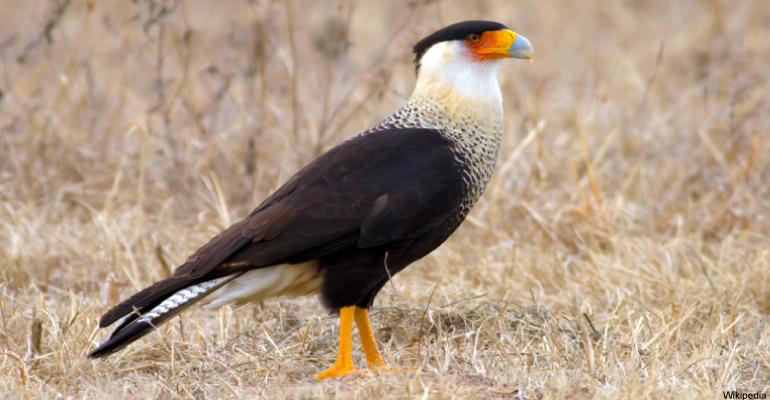
The Crested Caracara (Caracara cheriway) is a vulture-like falcon that looks like it is wearing a very bad black toupee.
Caracaras occur throughout Mexico, Central and South American and in southern Arizona, south Texas, and south Florida.
Normal habitat includes plains, savannahs, deserts and pampas, but it can be found in forests as well.
Caracaras are large birds with wingspans up to four feet. Males and females have the same plumage: a black-topped head, a bare, reddish-orange face and a white neck. The back and wings are dark brown to black; the legs and talons are yellow. The underside of the wings have white tips. The underside of the black tail has white at the rump. (See more photos here). In flight, caracaras could be mistaken for black vultures.
The manner of flight is raven-like: direct and purposeful with noisy wing beats. The long legs make caracaras agile on the ground and swift runners.
The name “caracara” is said to derive from its rasping call. Listen here to see if you agree.
Caracaras are opportunistic feeders. They are both scavengers and predators and will even eat vegetable matter. They scratch the ground like a chicken looking for insects. They hunt mice, amphibians, other birds, and reptiles, and supplement their diet by eating carrion, hence their vulture-like behavior.
And speaking of behavior, pairs of caracaras will bully other birds and steal their food.
Caracaras nest in tall trees and saguaros. Both male and female participate in nest-building, incubation, and feeding the chicks. The nest is a loose construction of sticks, leaves and dung. The female typically lays two to three eggs and the young are nurtured for two months. Adult birds normally stick to a territory, but young birds may wander over large distances.
According to the Arizona-Sonora Desert Museum, caracaras are long-lived birds. The record life-span for a captive bird is 42 years.
For ADI articles on other desert birds, see:
Cactus Wrens – Arizona’s very noisy state bird
Cardinals, Pyrrhuloxias and a cameo appearance by Phainopepla
Curve-billed Thrasher – a bold and inquisitive bird
Great Blue Herons in the desert
Nighthawks and Poorwills, birds of the night
